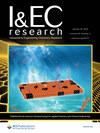利用机器学习策略进行冷却结晶工艺的数字化设计
IF 3.8
3区 工程技术
Q2 ENGINEERING, CHEMICAL
引用次数: 0
摘要
本研究介绍了一种基于机器学习的新型数字设计策略,用于预测冷却结晶工艺的最终产量和粒度分布(PSD)。所提出的方法将人工神经网络(ANN)与基于生成对抗网络的结晶过程模型(CrystGAN)相结合,前者用于关联操作条件和产品质量,后者用于生成新数据,从而减少了对大量真实数据集的依赖。仅用 30 组数据训练 CrystGAN 模型后,生成的产量值与实际值相比,均方根误差为 6.428,最大误差为 4.622。CrystGAN-ANN 耦合模型显示了预测性能,所有 Dv 预测的 R2 值均大于 0.93。该方法利用 l-谷氨酸结晶过程的模拟数据集进行了演示,并利用对甲苯磺酰胺结晶过程的新实验数据集进行了验证。所提方法对产品 PSD 和产量的平均预测误差均在 5%以内。与传统的机理模型开发和验证相比,所提出的策略大大减少了所需的实验工作量和设计复杂性,为工业应用中的结晶工艺设计和优化提供了一个稳健、可扩展的高效框架。本文章由计算机程序翻译,如有差异,请以英文原文为准。

Digital Design of Cooling Crystallization Processes Using a Machine Learning-Based Strategy
This study introduces a novel machine learning-based digital design strategy for predicting the final yield and particle size distribution (PSD) in cooling crystallization processes. The proposed approach integrates an artificial neural network (ANN) to correlate operating conditions and product qualities with a generative adversarial network-based model of the crystallization process (CrystGAN) to generate new data, thereby reducing the dependence on extensive real data sets. After training the CrystGAN model with only 30 data sets, the generated yield values showed an RMSE of 6.428 and an MAE of 4.622 compared to real values. The coupled CrystGAN-ANN model exhibited predictive performance, with R2 values greater than 0.93 for all Dv predictions. This method was demonstrated using a simulated data set of the l-glutamic acid crystallization process and validated using a new experimental data set of the p-toluenesulfonamide crystallization process. The average prediction error of the proposed approach was within 5% for both the product PSD and yield. The proposed strategy significantly reduces the experimental effort and design complexity required compared with traditional mechanistic model development and validation, offering a robust, scalable, and efficient framework for crystallization process design and optimization in industrial applications.
求助全文
通过发布文献求助,成功后即可免费获取论文全文。
去求助
来源期刊

Industrial & Engineering Chemistry Research
工程技术-工程:化工
CiteScore
7.40
自引率
7.10%
发文量
1467
审稿时长
2.8 months
期刊介绍:
ndustrial & Engineering Chemistry, with variations in title and format, has been published since 1909 by the American Chemical Society. Industrial & Engineering Chemistry Research is a weekly publication that reports industrial and academic research in the broad fields of applied chemistry and chemical engineering with special focus on fundamentals, processes, and products.
 求助内容:
求助内容: 应助结果提醒方式:
应助结果提醒方式:


